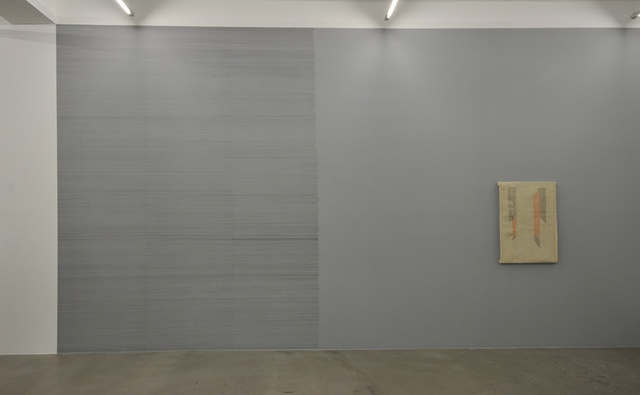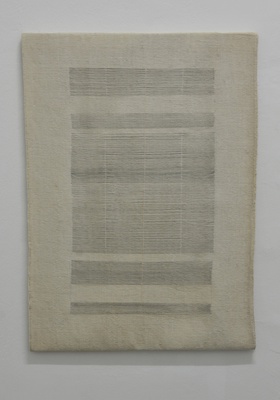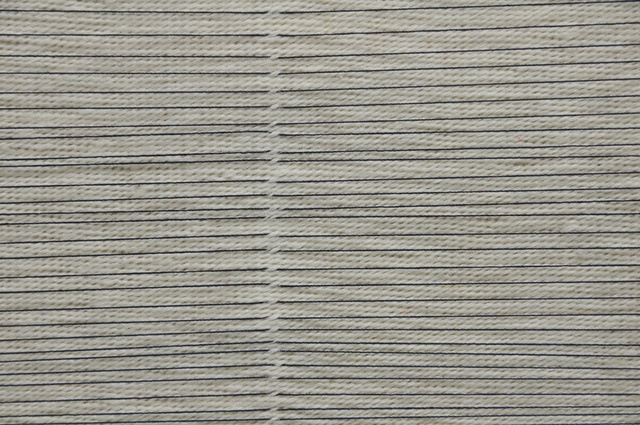Reviews
Flash Frozen Fire
Haleh Redjaian at Arratia Beer
The grid has been part of art since the very beginnings of abstraction. For many artists, it may serve as a simple way of ordering a surface. For Berlin-based artist Haleh Redjaian, it is far more than that. The use of elementary geometric forms and shapes – circles, squares, and lines – dominate her work. Instead of simply employing these elements as a tool for creating order, however, she uses them to create and modify space, to redefine spatial reception and recognition.
In her most recent body of work, on view at Berlin's Arratia Beer gallery the artist has chosen a support ground that couldn't be more opposite in terms of texture, material organization, and surface structure: handwoven carpets from Kerman, a region southeast of Tehran. Iranian carpet weaving enjoys a global reputation and is doubtlessly one of the most distinguished manifestations of Persian culture. This traditional handcraft is even part of UNESCO's Intangible Cultural Heritage of Humanity list. Each carpet tells a different story of the tribal and ethnic traditions influencing the designs and color choices, or the rites accompanying its creational process. And each design reveals the region it comes from, allowing us to identify its geographical origin. But what if the actual carpet is left blank – as pure white wool – with no design or weaving pattern telling us which region or village it may come from? Stripped of its identifying visuals, it bears little obvious signs of its provenance, yet its texture and intricate characteristics may still allude to its cultural origins. It still implies much of what it would have been praised for had its fabrication process been finished: the finest material, elaborate design, and glowing colour schemes. Redjaian uses these traditional carpets as an underlying basis for a complex, multi-layered structure of threads that she carefully applies to the surface to form abstract patterns. While traditional carpets have these coloured threads woven into them, the artist situates them on top, semi-attached to the actual rug. The artist appropriates traditional handcraft and manufacturing as a sub-font, superimposing a strict geometry onto this uneven surface. Treating the carpet like she would treat paper for a drawing, Redjaian is admittedly obsessed with the refined quality of material and surfaces. When stitching her lines, the artist carefully pulls out single bows to hold her threads. The contrasts between lines and carpet weaving yield a surprising three-dimensionality, surface tension, and unexpected shadows.
Seven works at the Berlin-based Arratia Beer gallery powerfully show Redjaian's approach-from preparatory drawings to full-scale, site-specific installations. Hundreds of fine black lines form the left half of a fully painted gray wall. On the right half, the artist has installed a white carpet that provides a support for her abstract stitching. From scale to color selection, the artist has built up a tension between different materialities, color-schemes and textures. Handwoven carpets, by nature, have fault lines, yellowish spots, and crinkled edges whereas her stitching and wall paint show carefully applied, heavily controlled geometric structures. The hierarchical distinctions between art and craft, or ornamentation and abstraction, vanish on the spot stress carpet weaving as a vital, medium-bending force, one that has long since absorbed the aspects of painting and calligraphy into its continually transforming structure.
The artist's use of carpets as a prominent, underlying material for this body of work perhaps misleadingly emphasizes her own heritage. As Redjaian clearly points out, her own biography is not her focus in making the work, though, 'Of course, my own cultural background has an impact on me – there are certain things and impressions that I can relate to differently than others and which carry a different meaning for me than for others. But my work points to a different aspect.' And when one shifts the emphasis away from the geographical background of the textile material, other formal and stylistic references become even more apparent. One could easily draw a comparison between Redjaian's meticulous stitching and Sonia Delaunay's cubist geometric drawings or Sol LeWitt's conceptual drawings. Thus, her appropriating of traditional Persian handcraft as a substructure for western artistic approaches to abstraction and experimentation appears as a most timely response to ongoing scholarly efforts. It also comes at a time when our established notions of materiality in art needs to be expanded and at least partially renegotiated. Dictionaries of material in art and studies of material culture have recently expanded their field significantly – both regionally as well as scope of cultures to be examined, though there is much need fur further expansion of the field. Particularly when it comes to meeting points of artistic practice and expression from varying geographic backgrounds.
In her work, Redjaian has mastered combining not only textiles' potential alterations as a medium support, but has also merged cultural influences, sources of inspiration, and iconographies. With her appropriation of material and form, she convincingly presents one viewpoint of her Berlin exhibition's overall intention: a contemporary and antithetic reflection on the meaning and relevance of abstraction today.

















